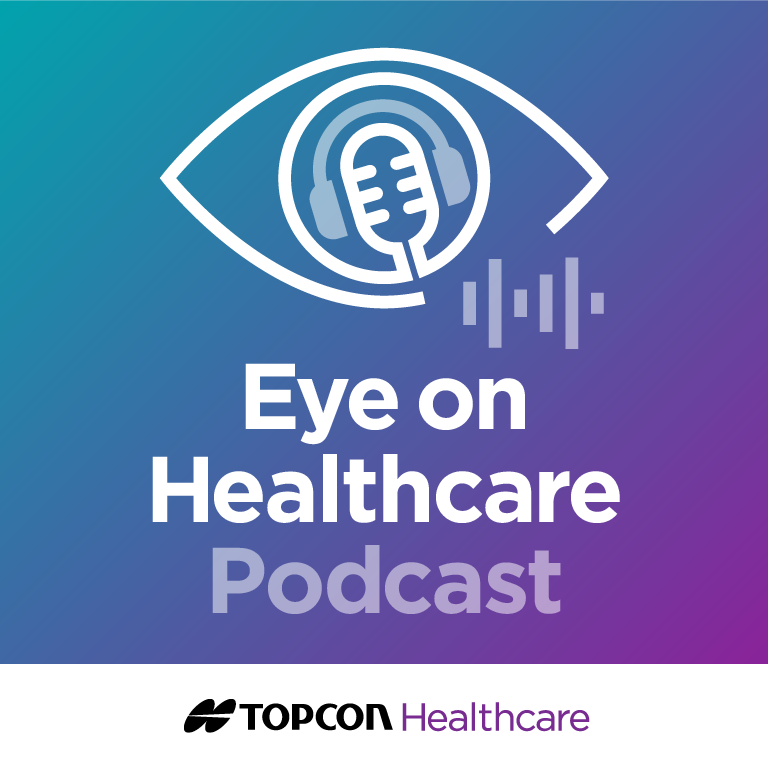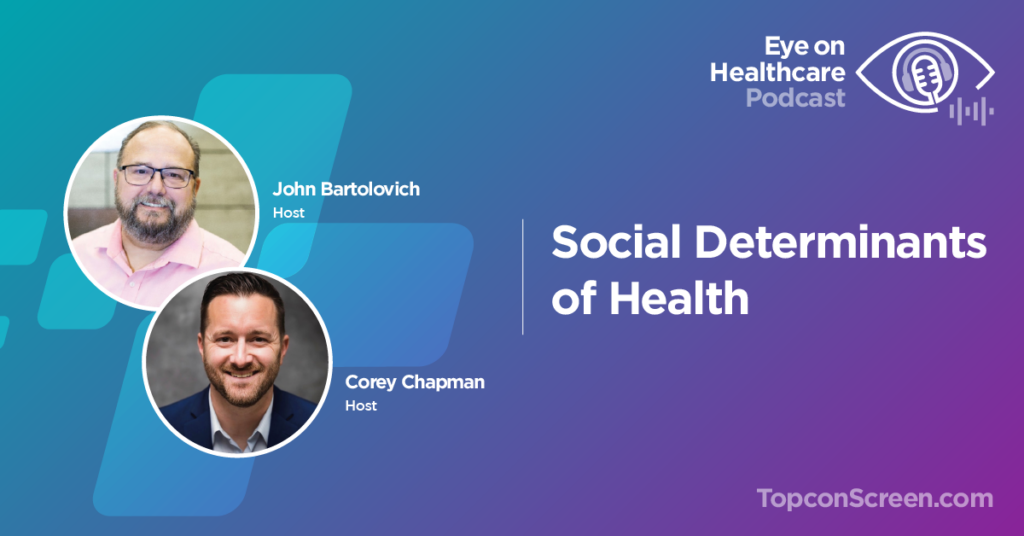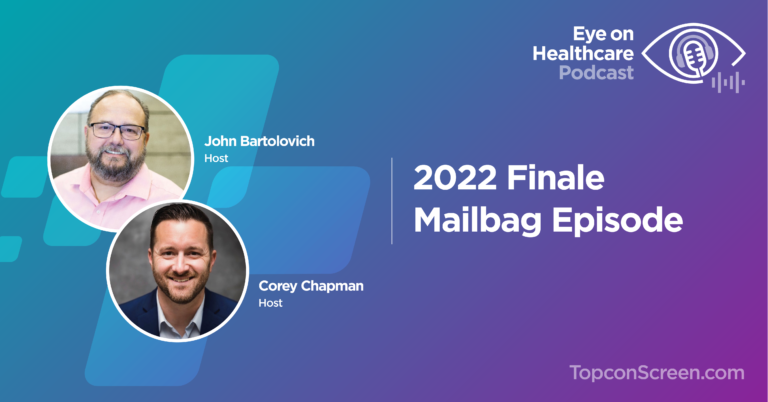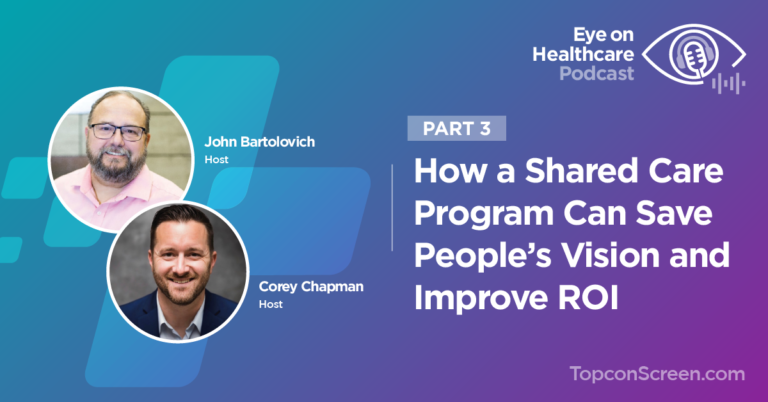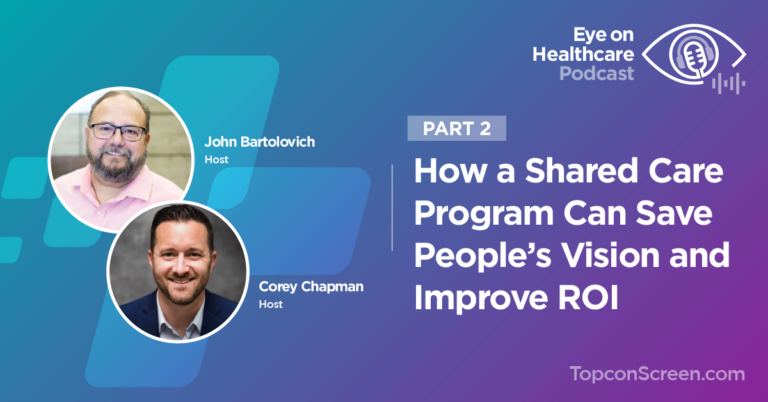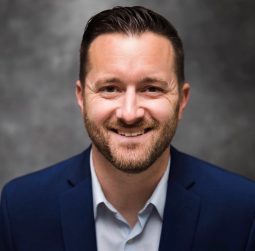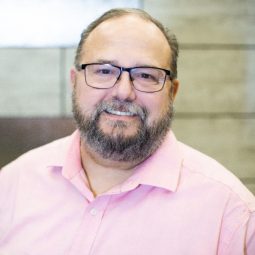Episode Transcript
Corey: Welcome to the Eye in Healthcare podcast I am your host Corey Chapman joined as always by my co-host John Bartolovich. John is the healthcare economics in reimbursement manager here at Topcon Healthcare Solutions. Hey John
John: Hey Corey. Good to be back for our second episode
Corey: Great to have you back. Last time we tackled HEDIS and great response to that one, great questions, great messages coming in about. We got a request to tackle FQHCs so I’m going to put this on you. I know there’s some challenges around discussing at FQHCs and how they work but I know you’re ready for it, so, here we go: for those who don’t know, what is an FQHC?
John: FQHCs are federally qualified health centers. They’re generally community-based providers that are receiving funding from HERSA, the health resources and services administration. They have to be very stringent requirements including providing sliding fee scales for people’s ability to pay, their governing body has to include patients of the FQHC, and you know they really are providing the safety net care for those individuals that really have little to no access to care
Corey: OK and so do they differentiate from other type of health centers or is it is it all under one umbrella under an FQHC? Who qualifies?
John: There are varied types of entities that qualify. I shouldn’t say any community Health Center but community health Centers for one, migrant health centers, health care for the homeless, health Centers for residents of public housing, and it really is any health care provider that is receiving funds from HERSA and get that designation
Corey: OK excellent, alright, so you see them pop up here and there, especially if you’re on LinkedIn and they’re always looking to help close gaps but how many are there overall in the US right now?
John: As of 2021 there are 1368 official FQHC locations in the US but when you couple in the lookalikes and service sites, it brings that number closer to 14,200. The interesting thing to note Corey is that FQHCs and their lookalikes serve between 28 and 30 million Americans for their health care
Corey: And then typically what socioeconomic level is it? is it more the underserved? Can you speak a little bit more about that?
John: Sure can. Many of the patients of an FQHC are on or below 200% of the poverty level, 82% of the patients are either uninsured or publicly insured, 63% are racial or ethnic minorities. I mean, it really is one in twelve Americans, one in nine children, one in five rural residents, one in three patients living in poverty and 1.3 million homeless people are getting their care from FQHCs and FQHC lookalikes
Corey: You talk about the uninsured. I guess my question is how are FQHCs funded then?
John: Well, they receive grants both from the public and private entities, so you know, obviously from the government, the private sector, and then they do get donations in addition to Medicare and Medicaid funding
Corey: OK so just I’m just trying to walk through the steps of a patient coming in, for say a yearly checkup, how is that paid for individually if, like you said, they are a little bit on the lower socioeconomic side? it’s just the grants themselves? they’re going to cover the cost of these tests?
John: It could but I guess the way to look at it is in any healthcare system there’s basically four payment silos: you have Medicare, you have Medicaid, and you have managed care, and you have those patients that are either self-paid or uninsured. So, when it comes to FQHCs, the Medicare pays them a flat rate or a perspective payment for all medically necessary health services and preventative health services that an FQHC practitioner provides so currently that rate is set at $176 per encounter. When a patient goes in, the FQHC will get 80% of that rate and that doesn’t matter if it’s a 10-minute visit or if it’s an hour-long visit, that’s what the FQHC is going to get. Same goes with Medicaid, again it it’s funded through a PPS system there are some alternative payment methodologies out there that states use, but most are on the PPS system as well but the nice thing with Medicaid is that those patients still can apply for Rep payments for services that generally aren’t covered. For instance, if an FQHC is offering the diabetic eye exam and it’s a Medicaid patient, they would get their PPS rate but then they could also apply for additional funds for the performance of that diabetic eye exam
Corey: Gotcha OK, but when it is a capped service and a capped rate, how does an FQHC expand into different testings when maybe it’s not covered? Is it the request of more grants? what motivates them to bring in new technology and new services to an office?
John: A lot of it comes down to Corey is there they’re looking to provide quality care and I mean really that’s the name says federally qualified Health Center but really, I saw a breakdown of the acronym FQHC that was more like this: F for fees based upon the ability to pay, Q quality health care for all, H health professional team so basically a one stop health hub home for patients, and then C for being community controlled. So, when you look at it that way, they’re really looking to provide quality care. The best outcomes, I should say, are coming from FQHCs because they really are looking at how we provide quality care with limited funds. Going back to address your question, yes, they can apply for grants if there’s a service they want to add they can apply for a grant to get it covered, they could apply to have their scope of services extended and that may increase the amount up to that $176 per encounter that they get or, interestingly enough, I had an administrator for an FQHC tell me just yesterday that what’s important to remember with these additional services is that even when an FQHC can’t bill or they can’t get a higher reimbursement amount aside from being the right thing to do for the patient, there are plenty of bonus dollars available from quality incentives that are often going to pay for these additional programs
Corey: Oh, that’s excellent. OK so, on the side of the FQHC, do they have people that, one, will seek out these grants and two do they have, you know, folks that are able to track these quality incentives as well or is that something like you know a vendor like Topcon would have to help on?
John: Well, I think when it comes to the grants, I think it may be a combination of yes, they may have some folks focused on getting grants, but you know they may require the assistance of somebody like a Topcon Screen and Topcon Healthcare who can provide assistance with that. I think when it comes to the quality metrics, they all have people on board that are geared to and looking at these quality metrics and the reason for that is they’re dealing with a mix of quality metrics, they’re dealing with UDS metrics, they’re dealing with HEDIS metrics, they have some commercial plans that they’re dealing with, so they’re getting a full gamut of desperate quality measures that they need to keep track of.
Corey: What are some of the more popular measures that are preventative and screening that are done in FQHCs? outside of retinal screening, what else do they seem to address?
John: Care for older adults is a big one, childhood immunization status, BMI assessments, colorectal, cervical and breast cancer screenings as well as the comprehensive diabetic care and the interesting thing kind of ties back to our conversation of last week, currently a lot of these include multiple components in the measure and neglecting one or two can throw the numbers way off
Corey: Oh, I see, so if you’re not doing all of them you may not qualify for some of those bonuses?
John: Exactly and again tying back to our conversation of last week, that’s where NCQA changing the comprehensive diabetes care measures helps because now they’re focusing on individual measures instead of a lump or grouping of measures that’s harder to track
Corey: Oh, wow, OK that makes a lot of sense, so you know, circling it back to what we do and how we do it, how can Topcon Screen help an FQHC?
John: Well first and foremost we do have the ability, with having a person on staff, that is able to help an FQHC go out and look for and apply for grants so that that’s one way of finding the additional funding. The other thing we have is, Topcon does offer the 90 day entry pilot program that allows an FQHC to get involved, bring the equipment in, get it working for 90 days, and that allows them to do a couple of things: it allows them to investigate how it’s going to affect their workflow but it also allows them to look at how they may be able to get commercial plans or other entities to pay for the equipment to support getting the exams done. The biggest component is going to be it’s definitely going to help them when it comes to addressing these quality measures around value-based care in improving outcomes for their patients and I think the bonus dollars are really, as the one administrator said to me, you know they often will pay for the program
Corey: Excellent. OK so if an FQHC was interested in screening or at least learning more about it, what would the next steps be for them?
John: Next step would be either to reach out to myself or to you Corey and we could begin the discussions, get a little better understanding of you know what their diabetic population looks like, what their mix for payment looks like, is it more tide to Medicaid? is it more tide to Medicare? is there any commercial payers involved to help them get a good gauge in understanding of what it’s going to look like once the program is up and running?
Corey: well John, this has been very informative, really appreciate you doing the research and giving us some knowledge on FQHCs. I know it’s a challenging topic, a lot of moving parts, a lot going on and different qualifications and different states, right? so a lot to gather around. Perfect John, thank you again for everything on this wonderful podcast. I feel much more qualified to talk about FQHCs now and let’s do it again next time. So, for John Bartolovich, I’m Cory Chapman, this has been another episode of the eye on health care podcast, happy holidays everybody!

